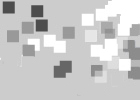Although somewhat begrudgingly at first, the high profile
institutions of the art word have begun to embrace Internet art.
Major art exhibits like the Whitney
Biennial and the Venice
Biennale display NET.ART and many major museums have held
showings for net.art as well as establishing online programs.
The Dia Center
for the Arts in New York sponsors ongoing projects of art
for the Internet. When NET.ART is displayed on the Internet is
is viewed in its intended environment and is therefore seen as
the artist originally intended. However, when a museum displays
net.art in the setting of a physical exhibit, a new set problems
are presented to the artist and the curator. Museums have attempted
to display NET.ART by installing multiple computer terminals in
their galleries. This did not work well since it intimidated the
patrons that were not computer literate, and even the computer
savvy patrons were not comfortable browsing ore engaging in interactive
art with others looking over their shoulders. Projection displays
have also been use to exhibit NET.ART. While this enlarges the
artwork it also tends to adulterate its visual quality. This also
made interactive art difficult as only one person could use the
controls of an image that sometimes dominated an entire room (Stallabrass,
p. 120). NET.ART has been presented in a variety of video installations
with only marginal results.
These
marginally successful attempts to display NET.ART in museum galleries
left most viewers with a viewing experience that was less than
satisfactory. It also left museum curators and directors apprehensive
and somewhat bemused about displaying NET.ART in their galleries.
To compound the problems most artists that contributed to the
shows were dissatisfied with the ways their art was being displayed.
Some museums began to commission traditional artists to create
Internet art, while some institutions sought out Internet artists
to create installations that were made for the gallery. At the
same time many Internet artists were looking for sponsors that
would be interested in similar endeavors. It appeared that NET.ART
was beginning to conform to many of the parameters of conventional
art. Natalie
Bookchin and Alexei Shulgin recognized this in 1999 when they
published Introduction
to net.art (1994-1999). This website is an outline of rules
and ideas that are intended as a guideline for the NET.ART artist.
In this writing they noted:
1. NET.ART is undertaking major transformations as a result of its newfound status and
institutional recognition.
2. Thus NET.ART is metamorphisizing into an autonomous discipline with all its
accouterments: theorists, curators, museum departments, specialists, and boards
of directors.
This short list was
followed by a brief list of things that would lead to the demise and
materialization of NET.ART. These included “…the production of objects, display
in gallery, archiving and preservation…” (Bookchin).
NET.ART was maturing. It had
grown past the simplicity of its infancy. It was no longer an underground art
form that was the bastion of the unknown artist and social dissident. It was
now important for artists to be recognized in this field. There was notoriety
to be had and commissions to be won. Institutions were beginning to understand
NET.ART and the artists were beginning to understand the business of art.
Advancements in technology helped bridge the culture gap and a mutually
beneficial relationship developed between the institution and the artist.
NET.ART was becoming a business.
Yet this was not new news
for the growing number of artists employed by the commercial interests
that used the Internet for commerce. Graphic designers, digital
artists, animators and dozens of other artistic disciplines had
found a home on the net. The “dot com” industry had been blossoming
for several years, and now it was in full bloom. NET.ART continued
to improve in both quality and quantity as American businesses
poured billions of dollars into Internet businesses. In addition
to this the video gaming industry had been exploding at exponential
rates for several years. This huge influx of cash fueled a revolution
in Internet technologies, including improvements in graphic, audio,
video and animation software. Digital artists now had more software
and hardware available to them than they could possibly master.
More and more the general field of digital art has segmented into
task specialization. Software has become so complex that it is
common to have artists that specialize in one specific software
program. Technology is changing the face of digital art, and NET.ART
is changing with it.


